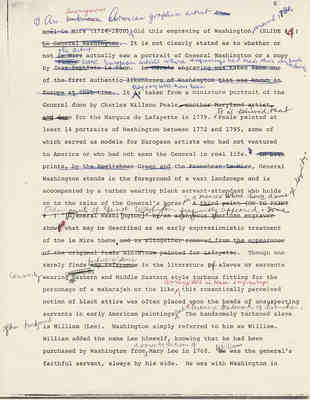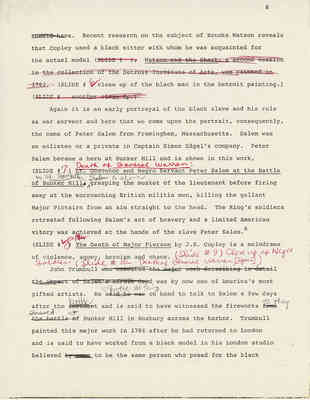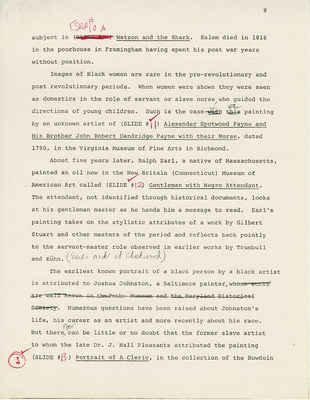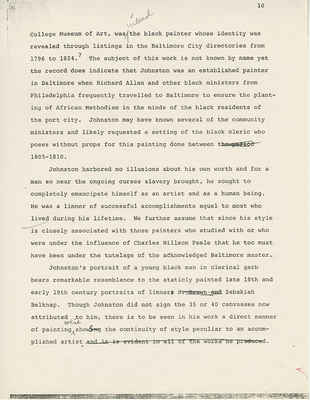Pages
MS01.01.03.B01.F25.006
An anonymous [deleted: unknown] American graphic artist did this engraving of Washington around 1780. (SLIDE #4) [deleted: ] [ul] Le General Washington [/ul]. It is not clearly stated as to whether or not [deleted: le Mire] actually saw a portrait of General Washington or a copy by [deleted: Jean Baptiste Le Paon] some European artists whose engravings had made their way back to America. [deleted: Le Mire's engraving was taken from one of the first authentic likenesses of Washington that was known in Europe at that time.] It may very well have been taken from a miniature portrait of the General done by Charles Willson Peale [deleted: another Maryland artist, and done] for the Marquis de LaFayette in 1779. It is believed that Peale painted at least 14 portraits of Washington between 1772 and 1795, some of which served as models for European artists who had not ventured to America or who had not seen the General in real life. [deleted: in both prints, by the Englishman Green and the Frenchman Le Mire,] General Washington stands in the foreground of a vast landscape and is accompanied by a turban wearing black servant-attendant who holds on to the reins of the General's horse in a manner which shows a sense of loyalty. [deleted: A third print (ON TO PRINT # ) "[G]eneral Washi[ngton]" by an anonymous American engraver] Other prints of General Washington frequently appeared. Some show what may be described as an early expressionistic treatment of the le Mire theme. [deleted: and is altogether removed from the appearance of the original Peale miniature painted for Lafayette.] Though one rarely finds [deleted: any reference] factual evidence in the literature of slaves or servants commonly wearing [deleted: commonly] Eastern and Middle Eastern style turbans fitting for the personage of a maharajah or the like, as suggested in these engravings this romantically perceived notion of black attire was often placed upon the heads of unsuspecting servants in early American paintings and it became a trademark of distinction. The handsomely turbaned slave often turbaned is William (Lee). Washington simply referred to him as William. William added the name Lee himself, knowing that he had been purchased by Washington from a woman by the name of Mary Lee in 1768. [deleted: He] William was the general's faithful servant, always by his side. He was with Washington in
MS01.01.03.B01.F25.007
7 [ul] Edward Savage [/ul]
Massachusetts in 1775 and remained with him until the end of the Revolutionary War. William is the servant seen standing in Edward Savage's famous painting of the Washington family executed in 1796 and shown here. Washington always referred to William as a Mulatto and decreed in his will that upon his death. . . . "my Mulatto man William (calling himself William Lee) I give immediate freedom. . . . I allow him an annuity of thirty dollars during his natural life . . . and this I give you as a testimony of my sense of his attachment to me, and for his faithful services during the Revolutionary War." 4 Washington granted William the extraordinary favor of permitting him to take a wife, a free woman of color from Philadelphia in the year 1784. [deleted: and bring] her to Mount Vernon. Thus, we are able to identify an early black subject in several artists' works because of the fidelity which existed between master and slave. The living Lees of Fairfax County, Virginia are said to be the lineage descendants of William Lee, Washington's servant.
Other subjects in which Blacks were depicted prior to the 19th century dealt with historical events in which acts of courage and heroic deed were seen. Such is the case in the masterwork by John Singleton Copley entitled (SLIDE #5) [ul] Brooks Watson and the Shark [/ul]. Other paintings of the subject by Copley are to be found at The National Gallery of Art and the Detroit Institute of the Arts. The painting in the Museum of Fine Arts in Boston [deleted: is one of several by the same title. It] was completed in 1778 in time to be entered into the Royal Academy Exhibition of 1779. The black man standing with outstretched arms gestures so as to help rescue Brooks Watson, who lost a leg to [deleted: the] a "Jaws like creature" in the waters of Havana harbor where the incident is said to have taken place when Watson was a young man of 14 years. 5 [deleted: The] But Copley makes the black man [deleted: is] an equal passenger in the Painting. [deleted: in the sense of] His equality is registered through his humility and concern [deleted: but also in the compositional soundness of Copley's understanding of the construction of a painting which honors the pyramidal grouping a composition of this nature] for his fellowman. Thus he reaches out, a human act, to help save Watson.
MS01.01.03.B01.F25.008
8
[crossed out: should have.] Recent research on the subject of Brooks Watson reveals that Copley used a black sitter with whom he was acquainted for the actual model. [crossed out: (SLIDE # ). Watson and the Shark, a second version in the collection of the Detroit Institute of Arts, was painted in 1782.] (SLIDE # 6 close up of the black man in the Detroit painting.) [crossed out: SLIDE # another close up.]
Again it is an early portrayal of the black slave and his role as war servant and hero that we come upon the portrait, consequently, the name of Peter Salem from Framingham, Massachusetts. Salem was an enlistee or a private in Captain Simon Edgel's company. Peter Salem became a hero at Bunker Hill and is shown in this work, (SLIDE # 7) [u] Death of General Warren: Lt. Gosvenor and Negro Servant Peter Salem at the Battle of Bunker Hill by John Trumbull[/u]. Salem is shown grasping the musket of the lieutenant before firing away at the encroaching British militia men, killing the gallant Major Pictairn from an aim straight to the head. The King's soldiers retreated following Salem's act of bravery and a limited American vitory [victory] was achieved at the hands of the slave Peter Salem.6
(SLIDE # 8) [u] The Death of Major Pierson [/u] by J.S. Copley is a melodrama of violence, agony, heroism and chaos. (SLIDE # 9) Close-up of Negro soldier. (SLIDE # 10 -- Death of General Warren [again]).
John Trumbull who [crossed out: executed the major work describing in detail the impact of Salem's heroic deed] was by now one of the America's most gifted artists. He is quoted as being on hand to talk to Salem a few days after the [crossed out: incident] battle and is said to have witnessed the fireworks [crossed out: from the battle of] as they ensued at Bunker Hill in Roxbury across the harbor. Trumbull painted this major work in 1786 after he had returned to London and is said to have worked from a black model in his London studio believed [crossed out: by some] to be the same person who posed for the black
MS01.01.03.B01.F25.009
9
subject in SLIDE #10A [u] Watson and the Shark[/u]. Salem died in 1856 in the poorhouse in Framingham having spent his post war years without position.
Images of black women are rare in the pre-revolutionary and post revolutionary periods. When women were shown they were seen as domestics in the role of servant or slave nurse, who guided the directions of young children. Such is the case [crossed out: with this] in a painting of an unknown artist of (SLIDE # 11) [u] Alexander Spotwood Payne and His Brother John Robert Dandridge Payne with their Nurse [/u], dated 1790, in the Virginia Museum of Fine Arts in Richmond.
About five years later, Ralph Earl, a native of Massachusetts, painted an oil now in the New Britain (Connecticut) Museum of American Art called (SLIDE # 12) [u] Gentleman with Negro Attendant [/u]. The attendant, not identified through historical documents, looks at his gentleman master as he hands him a message to read. Earl's painting takes on the stylistic attributes of a work by Gilbert Stuart and other masters of the period and reflects back pointly [pointedly] to the servant-master role observed in earlier works by Trumbull and Kuehn. (Earl's work at Cheekwood)
The earliest known portrait of a black person by a black artist is attributed to Joshua Johnston, a Baltimore painter. [crossed out: whose works are well known in the Peale Museum and the Maryland Historical Society.] Numerous questions have been raised about Johnston's life, his career as an artist and more recently about his race. But there now can be little or no doubt that the former slave artist to whom the late Dr. J. Hall Pleasants attributed the painting (SLIDE #13) [u] Portrait of A Cleric [/u], in the collection of the Bowdoin
MS01.01.03.B01.F25.010
10
College Museum of Art, was indeed the black painter whose identity was revealed through listings in the Baltimore City directories from 1796 to 1824. 7 The subject of this work is not known by name yet the record does indicate that Johnston was an established painter in Baltimore when Richard Allen and other black ministers from Philadelphia frequently travelled to Baltimore to ensure the planting of African Methodism in the minds of the black residents of the port city. Johnson may have known several of the community ministers and likely requested a setting of the black cleric who poses without props for this painting done between [crossed out: the period] 1805-1810.
Johnson harbored no illusions about his own worth and for a man so near the ongoing curses slavery brought, he sought to completely emanicipate himself as an artist and as a human being. He was a limner of successful accomplishments equal to most who lived during his lifetime. We further assume that since his style is closely associated with those painters who studied with or who were under the influence of Charles Willson Peale that he too must have been under the tutelage of the acknowledged Baltimore master.
Johnson's portrait of a young black man in clerical garb bears remarkable resemblance to the staticly painted late 18th and early 19th century portrains of limner [crossed out: [s] J. Brown and] Zebakiah Belknap. Though Johnston did not sign the 35 or 40 canvasses now attributed to him, there is to be seen in his work a direct manner of painting which shows [crossed out: [-ing]] the continuity of style peculiar to an accomplished artists. [crossed out: and it is evident in all works he produced]






